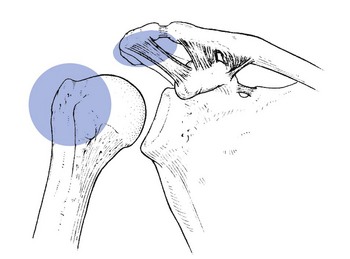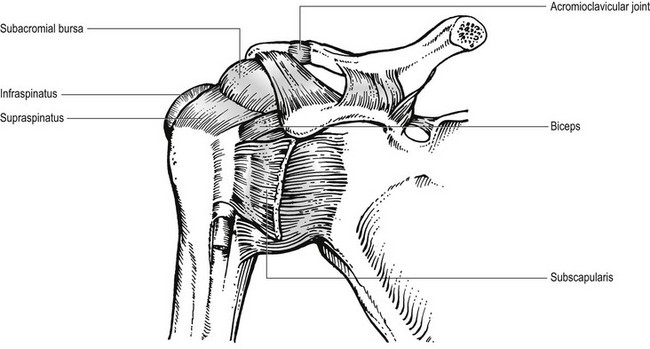A painful arc is pain felt at about half range in a movement, in the absence of pain before and after the mid-range (see p. 213). Pain may or may not recur at the end of the movement. An arc results from a momentary impingement of a lesion, lying in such a position that it is caught between the lesser or greater humeral tuberosities and the overlying anterior part of the acromion, the coracoacromial ligament or the acromioclavicular joint1–4 (Fig. 1). A painful arc is mainly found on elevation, sometimes on medial rotation of the arm. Irrespective of the precipitating movement, the diagnostic significance remains the same: temporary impingement. An arc on elevation is usually most pronounced during the active movement, and more on the way up than on the way down. This is due to the muscular activity, which pulls the humeral head closer to the acromion during active elevation.5 Neer introduced the term ‘impingement syndrome’, now widely recognized and further divided into a ‘subacromial’ and a ‘subcoracoid’ impingement syndrome.6–9 Cyriax always considered painful impingement as a sign rather than a syndrome: it does not implicate just one lesion but one of several.10,11 Since the exact diagnosis is in the majority of the cases based on other tests – very often on resisted movements – a painful arc usually has value as a localizing sign, defining exactly in which particular part of the structure the lesion lies. Movement in the subacromial space is between a convex, cuff-covered proximal humerus and a concave surface consisting of the coracoacromial roof and the inferior part of the acromioclavicular joint.12 The gliding surface between these two moving spheres is the bursa. Pathology in one or more of these structures may partly interfere with movement and thus cause the clinical sign, ‘painful arc’ (Fig. 2). In practice, the arc is seldom found because the patient presents 2–3 days after the onset, once the pain has become unbearable. At this stage, the pain is so severe that active and passive elevation beyond the horizontal is not possible (see p. 234). When an arc is very pronounced, the diagnosis is most probably chronic subdeltoid bursitis. Occasionally, the arc is very subtle. It may be absent on lateral elevation, but when it is repeated with the arm anteriorly it may show. The same goes for lateral elevation with the arm in medial or lateral rotation. In these cases, elevation should be repeated in several different ways (see p. 246).
Disorders associated with a painful arc
Disorders of the inert structures
Acute subdeltoid bursitis
Chronic subdeltoid bursitis
associated with a painful arc






